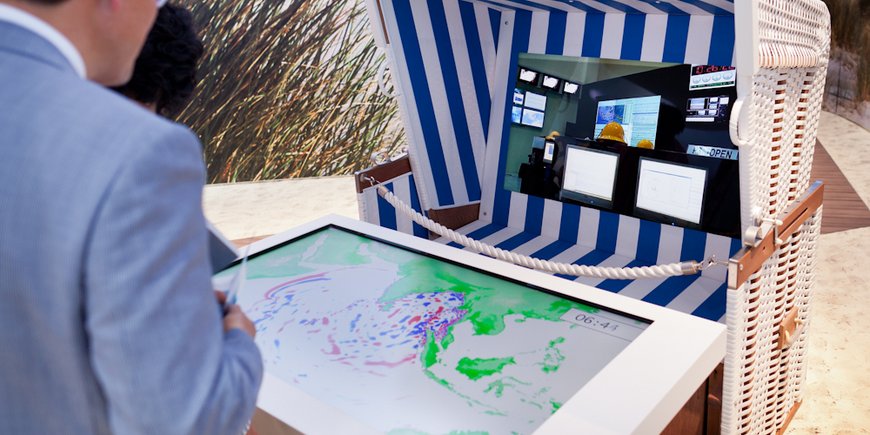Future-oriented solutions to global challenges - Tsunami
15.06.2012 | Potsdam: This Friday, 15 June 2012, is the German Nations Day at the Expo 2012 in Yeosu, South Korea. The German Research Centre for Geosciences GFZ participates in this year's World Expo. In the German pavilion, visitors are greeted by German “Strandkörbe”: roofed wicker beach seats, multimedia assisted to show the issues of life on the coasts and in coastal waters. One beach chair is dedicated to tsunami early warning systems. The Centre for Early Warning at the GFZ advised the exhibitors with regard to scientific content. But not only that, the geoscientists Dr. Andrey Babeyko and Dr. Peter Löwe calculated simulations of historical tsunami events and presented them graphically.
Visitors to the German Pavilion can various marine earthquakes via a touchscreen. The computer simulation shows how the waves spread from the epicenter of an earthquake in each direction towards the coast and illustrates the operation method of a tsunami early warning system. Visitors learn about the global spread of giant waves on the basis of the three sample regions Pacific, Indian Ocean and Mediterranean Sea. Simulations of the tsunami events in Japan 2011, Indonesia and Algeria in 2004 / Mallorca 2003 are shown. Color codes indicate what height individual waves can reach when they arrive at the coasts.
In addition, image and video material was provided by the German Indonesian Tsunami Early Warning System (GITEWS). The early warning system in the Indian Ocean was created as part of the flood relief aid after the tsunami in 2004. The German federal government contracted the Helmholtz Association under the auspices of the GFZ to construct such a warning system. It is the most advanced of its kind and was formally handed over to Indonesia on 29 March 2011.
Tsunami are a global problem, and the coasts of the Mediterranean are threatened by the giant waves due to the active tectonics in this region. There are already plans of several neighboring states to also install an early warning system here. The experience and latest research results of the GFZ can provide a valuable contribution to all regions with earthquake-/tsunami risks.
Further information can be found here:
www.expo2012-germany.com/de/deutscher_pavillon/pavillon.php
Images in printable resolution








![[Translate to English:] Torsten Sachs in front of a climate station on a field](/fileadmin/_processed_/3/9/csm__TorstenSachs_bearbeitet_GS_4a1365ef84.jpeg)

![[Translate to English:] left image flood at the Ahrtal: image from above, several houses are flooded; left image:: Heidi Kreibich;](/fileadmin/_processed_/4/4/csm_Bild2_9af0130e9f.png)



![[Translate to English:] Start der Vega Rakete](/fileadmin/_processed_/6/4/csm_20231201-kachel_Vega-VV23-launch_ESA-CNES-Arianespace_706716b68c.jpeg)









![[Translate to English:] Poster exhibition at the Brandenburg Hydrogen Day at the GFZ, some participants in the foreground](/fileadmin/_processed_/6/5/csm_Erster_Brandenburgischer_Wasserstofftag_GFZ_402fcec95e.jpeg)
![[Translate to English:] Group picture of the participants](/fileadmin/_processed_/9/4/csm_20231108_CAWa-Workshop-Tashkent_Gruppenbild_99ea779d8a.jpeg)

![[Translate to English:] [Translate to English:] Hörsaal](/fileadmin/_processed_/e/6/csm_H%C3%B6rsal_e21ac645fb.jpeg)


![[Translate to English:] The Delegations in the Historic Library on the Telegrafenberg. In the back there are from left to right, the Dutch Ambassador for Germany, Ronald van Roeden, the Dutch Minister for Education, Culture and Science, Robbert Dijkgraaf and the scientific director of the GFZ, Susanne Buiter.](/fileadmin/_processed_/d/b/csm_Kachel-2_9eba4b4212.jpeg)

